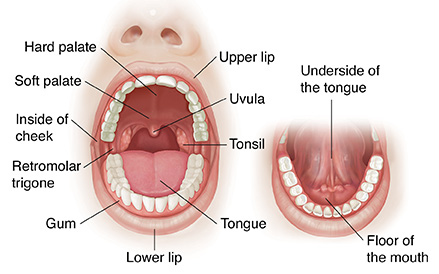Oral Cancer: Introduction
What is cancer?
Cancer starts when cells in the body change (mutate) and grow out of control. Your body is made up of tiny building blocks called cells. Normal cells grow when your body needs them and die when your body doesn't need them any longer. Cancer is made up of abnormal cells that grow even though your body doesn’t need them.
In most types of cancer, the abnormal cells grow to form a lump or mass called a tumor. Cancer cells can also grow into (invade) nearby areas. They can spread to other parts of the body, too. This is called metastasis.
What is oral cancer?
Oral cancer is cancer that starts in cells in the mouth or throat. Oral cancer is fairly common and often cured if found and treated at an early stage. (This is when the cancer is small and hasn't spread.) A healthcare provider or dentist often finds oral cancer in its early stages because the mouth is easy to examine.
Oral cancer is a type of head and neck cancer.
Understanding the mouth and throat
The mouth is also called the oral cavity. It includes many parts:
-
The lips
-
The lining inside the lips and cheeks (called the buccal mucosa)
-
The front two-thirds of the tongue
-
The gums and teeth
-
The bottom (or floor) of the mouth
-
The bony top of the mouth (hard palate)
-
The area behind the wisdom teeth (retromolar trigone)
The back or base of the tongue, the back of the roof of the mouth (soft palate), and the tonsils are not part of the oral cavity. Instead, they are part of the region called the throat or oropharynx.
Every part of the mouth has an important function. For instance, the lips are needed to speak. The tongue is also key to speaking and for swallowing. The gums help protect the teeth and keep them healthy.
Cancers of the oral cavity can affect how you chew, swallow, talk, and can sometimes even affect breathing.

Types of oral cancer
More than 9 in 10 oral cavity tumors are squamous cell carcinoma. Squamous cells make up the lining of the oral cavity (the mucosa). As cancer in the mouth's lining grows, it can spread into nearby tissues.
Verrucous carcinoma is a rare type of squamous cell carcinoma. It's a low-grade or slow-growing type that rarely spreads to distant sites (metastasizes).
Other much less common types of oral cancer include salivary gland tumors, including adenoid cystic carcinoma and adenocarcinoma, and lymphoma.
Talk with your healthcare provider
If you have questions about oral cancer, talk with your healthcare provider. They can help you understand more about this cancer.
Online Medical Reviewer:
Amy Finke RN BSN
Online Medical Reviewer:
Jessica Gotwals RN BSN MPH
Online Medical Reviewer:
Todd Gersten MD
Date Last Reviewed:
7/1/2023
© 2024 The StayWell Company, LLC. All rights reserved. This information is not intended as a substitute for professional medical care. Always follow your healthcare provider's instructions.